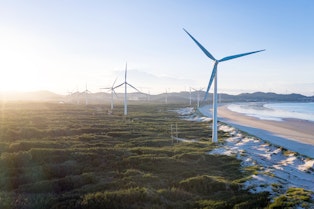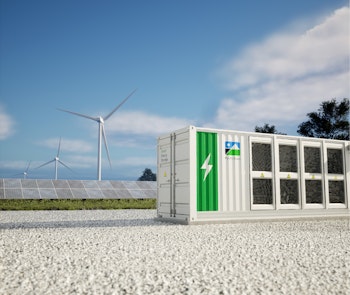
Pacific Green’s plans for new battery capacity in Australia are highlights in the country’s dynamic energy storage market. But it is a market that is full of highlights, and one of the top ones in the world in terms of energy storage capacity per capita.
Storage developments have grown on the back of an energy transition in Australia that, as in other countries, has been shepherded into existence out of concern for the environment.
Australia’s position as a major coal and gas exporter has meant environmental concerns have competed with economic priorities, often with contrasting outcomes at state and federal level.
One of the first federal programmes aimed at growing the country’s share of clean power came in 2001, when the Australian Government introduced a mandatory renewable energy target of 2% of total electricity generation in hope of encouraging large-scale solar and wind development.
In 2009, this was raised to 20%, equivalent to 41 terawatt-hours of renewable generation a year, then shortly after lowered to 33 terawatt-hours by the Abbott government, which was in power from 2013 to 2015.
By 2017, and despite cuts to funding by the Abbot government, 39 solar and wind projects with a combined capacity of 3.9 GW were being built, or about to start construction, across the nation.
At this point, the need for energy storage was already becoming clear, with a growing proportion of Australia’s coal fleet nearing the end of its life and grid constraints emerging in states such as South Australia.
Traditionally in Australia, as in other countries, the only form of energy storage used at scale had been pumped hydro. Even in 2022, hydro power supplied 19.7% of Australia's renewable generation, and 7.1% of Australia's total electricity production.
The home of pumped hydro storage in Australia is the Snowy Mountains.
A Snowy Mountains hydroelectric scheme consists of nine power stations, two pumping stations and sixteen large dams connected by 90 miles of tunnels and 50 miles of aqueducts, located mostly in the Kosciuszko National Park in New South Wales.
Construction of a much-anticipated Snowy 2.0 pumped storage power station began in 2019. It is expected to supply 2.2 GW and 350 GWh of large-scale storage capacity to the grid.
Designed to stabilize the grid for times when solar and wind are not able to provide power, the project should be able to deliver energy for up to 175 hours and remains by far the largest storage scheme in the country, albeit that it might not go live until 2027 owing to ongoing problems.
Another early energy storage contender that has so far had even less luck in Australia than pumped hydro is concentrated solar power, or CSP. The technology itself does not store energy but produces it by concentrating heat from the sun on a fluid that can then power a steam turbine.

However, CSP plant designers early on realised that the heat did not have to be used immediately and, if stored in the right medium, could power turbines long after the sun had gone down.
Australia pioneered some of these CSP and thermal storage systems, experimenting with media such as graphite. Ultimately, however, only a handful of CSP plants were built in Australia, and only a couple remain in operation today.
Despite this, the technology, which Pacific Green is a world leader in, remains of interest for the Australian market.
According to a renewable energy storage roadmap released earlier this year by the Commonwealth Scientific and Industrial Research Organisation (CSIRO), CSP is expected to become the most cost-effective method for storing energy for eight to 24 hours by 2050.
Developing this medium-duration storage could be valuable in phasing out fossil-fuelled power, which predominantly operates during the night.
Yet while CSP waits to scale further, and pumped hydro works through development challenges, another energy storage technology category—batteries--has seen rampant growth and continues to expand apace.
Australian innovation played an early part in battery technology development, with CSIRO combining a supercapacitor and a lead-acid battery in a single unit back in the early 2000s. This so-called UltraBattery was spun out under a brand called Ecoult that survived until 2021.
Another Australian battery innovator—with so far better fortunes—is Redflow, which provides zinc-bromine flow batteries. But without doubt the battery technology that has made the biggest difference to Australia’s energy storage market is lithium-ion.
The technology was barely heard of until 2017, when Tesla boss Elon Musk made a sensational bet with Atlassian chief Mike Cannon-Brookes. Musk claimed Tesla would install a large battery system to solve energy issues in South Australia within 100 days—or give it away free.
The bet led to the installation of what was then the world’s biggest lithium-ion battery plant, the Hornsdale Power Reserve, in South Australia. Although Hornsdale has since been superseded in size, it sparked a rage for large battery installations that continues to this day.
There are 18 projects with capacities over 10 MW in operation today and a further 19 being built. Pacific Green will be adding to this pipeline after entering into an exclusivity agreement to secure strategic land sites in South Australia and Victoria.
Construction is slated to begin in 2024, with operations following in 2026. And Australia’s energy storage story does not end here. The country is also a global leader in residential battery storage, with 589 MWh installed in 2022 alone—up 55% from the 2021 level.
Australia’s energy storage capacity is set to grow much further as the nation switches to electric vehicles. Thanks to an emerging technology called vehicle-to-grid, each of these could one day act as a mini grid storage asset.
And finally, there are Australia’s plans for molecular energy storage, in the form of low-carbon hydrogen, ammonia, or both. Looking at the vast opportunities ahead, it is clear Australia’s long and illustrious history in energy storage is just a taste of things to come.
Publish date: 28 March, 2024